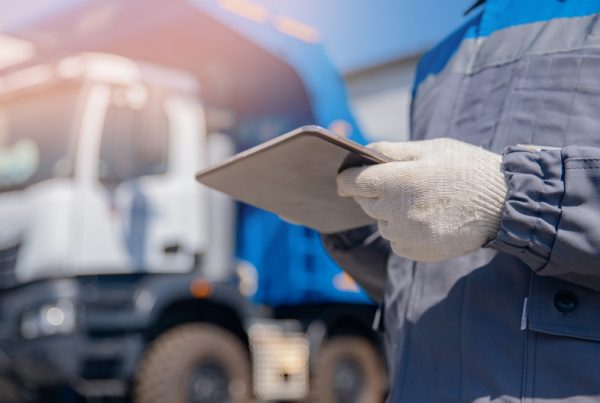Truck drivers seldom look forward to the prospect of being pulled over for a DOT inspection. However, it’s an essential part of the job and you always need to be prepared for it. There’s no need to worry about getting inspected as long as you know what to expect.
Let’s look at everything you need to check to ensure your vehicle is ready for a DOT inspection.
What Are the Types of DOT Inspections?
There are six levels of inspection for trucks, Level 1 through Level 6. Here’s a rundown of what each level involves.
Level 1: North American Standard Inspection
The most common type of DOT inspection involves inspecting both the driver and vehicle. The driver should be ready to show the inspector documents such as a driver’s license, Driver’s Daily Log and Hours of Service, and the Driver and Vehicle Inspection Report (DVIR). You should also be prepared for the following vehicle areas to be inspected
- Brakes and Tires
- Driver Fitness (for example: license, medical card, logbook, sobriety)
- Coupling devices
- Exhaust system
- Fuel system
- Electrical cables
- Emergency exits
- Frame
- Headlamps, stop lamps, brake lamps, and tail lamps
- Horn
- Safe loading
- Seatbelt
- Securing of cargo
- Steering mechanism
- Suspension
- Turn signals
- Wheels, rims, and hubcaps
- Windshield wipers
Level 2: Walk-Around Driver/Vehicle Inspection
In a Level 2 inspection, the inspector will check all systems that don’t involve looking under the vehicle, so it’s less exhaustive.
Level 3: Driver-Only Inspection
A Level 3 inspection is a thorough inspection of the driver, which may include the following.
- Record of Duty Status (RODS)
- Driver’s license
- HAZMAT requirements
- Medical card and waiver
- Skill Performance Evaluation (SPE) certificate
- Vehicle Inspection Report
- HM/DG requirements
- HOS documentation
- Seat belt
- Alcohol or drug use
Level 4: Special Inspections
Level 4 inspections are done to inspect a particular vehicle feature, usually as a follow-up from a previous inspection.
Level 5: Vehicle-Only DOT Inspection
A Level 5 inspection is similar to a Level 1 inspection but is conducted without the driver present. These are often performed at a carrier’s facility or during compliance reviews. Inspectors will check all critical vehicle components, such as:
- Brakes and brake connections
- Lighting and reflectors
- Suspension and steering systems
- Fuel and exhaust systems
- Tires, wheels, and rims
- Cargo securement
- Coupling devices
- Emergency equipment
Because the driver isn’t present, documentation like the driver’s logbook or license isn’t reviewed. Level 5 inspections are commonly used to ensure fleet-wide compliance and are especially important for maintaining a strong DOT safety rating.
Level 6: Enhanced NAS Inspection
Level Vl inspections are specialized inspections only for vehicles traveling with Highway Route Controlled Quantities (HRCQ) or radioactive materials.
How to Prepare For a DOT Inspection
You need to be prepared for any type of DOT inspection that’s relevant to your vehicle and the type of load you’re carrying. Here are some guidelines to make sure you’re prepared.
- Know the regulations. The first step to preparing for a DOT inspection is to understand the regulations that govern your vehicle and cargo. The Federal Motor Carrier Safety Administration (FMCSA) publishes a comprehensive set of regulations that you can find on their website.
- Have your paperwork ready. You should have all the necessary documents ready so you can quickly produce them in the event of an inspection.
- Keep vehicles in good working condition. If you fix any issues promptly and keep all your truck’s parts in good order, you have nothing to worry about.
- Do your own pre-trip inspections. Before embarking on a trip, conduct your own inspection that mimics the DOT Level 1 inspection, thoroughly examining every part and system.
- Review driver training, habits, and practices. Reinforcing proper driving habits is essential for passing inspections. Drivers should review their training and make sure they are sufficiently rested and not distracted.
What to Do During and After a DOT Inspection
Truck drivers should always be prepared for an inspection and conduct themselves professionally towards inspectors. Drivers should bring the inspection summary to their supervisor so any violations can be addressed. If drivers aren’t clear about anything, they should ask the inspector for clarification.
Stay Inspection-Ready with Transportation Factoring
DOT inspections are just one part of running a successful trucking operation. As with any area of your business, the key to staying prepared is having the right systems in place – including your finances. One way to improve stability and reduce stress is by using transportation factoring.
Transportation factoring allows you to sell your freight bills to a factoring company and receive quick cash advances – often within 24 hours. This helps cover fuel, maintenance, and other expenses without waiting on client payments.
Riviera offers fast, flexible transportation factoring solutions to help truck drivers and fleet owners maintain steady cash flow. Learn more about why businesses choose Riviera for their funding needs, from excellent customer service to decades of industry expertise.
Want to see how factoring can help your business? Contact Riviera Finance today and talk to a representative about your options.
You Might Also Be Interested in the Following Articles:
Riviera Finance Fuel Card
Fuel discounts / 1,800 locations nationwide / Convenience
Fuel Discounts – Substantial savings at TA and Petro, Speedway, Roady’s & many other locations nationwide
100% Transparency – No account set-up fees or monthly maintenance fees, and low transaction fees
Mobile App / Online Resources – 24/7 Access to Fuel Finder Tool and Online Resources
Universally Accepted – Accepted nationwide at all major chains including Pilot, Flying J & Love’s
Our Process

STEP 1
Apply
Complete form & become a Riviera client

STEP 2
Service
You deliver your products or services

STEP 3
Send
Send your invoices to Riviera Finance






